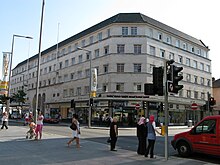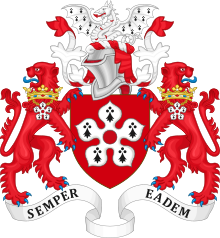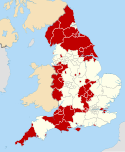Leicester City Council
Leicester City Council | ||
|---|---|---|
Chief operating officer | Alison Greenhill since 1 March 2021[2] | |
| Structure | ||
| Seats | 1 executive mayor 54 councillors[3] | |
 | ||
Political groups |
| |
Length of term | Executive mayor elected every four years Whole council elected every four years | |
| Elections | ||
Plurality-at-large | ||
| First-past-the-post voting | ||
Last election | 4 May 2023 | |
Next election | 6 May 2027 | |
| Meeting place | ||
 | ||
| Town Hall, Town Hall Square, Leicester, LE1 9BG | ||
| Website | ||
| www | ||
Leicester City Council is a
The main council offices are at City Hall on Charles Street, but council meetings are held at Leicester Town Hall, completed in 1876.[4]
As a unitary authority, the council is responsible for running nearly all local services in Leicester with the exception of the
History
The Council traces its roots to the Corporation of Leicester, and before then to the Merchant Gild and the Portmanmoot. The Portmanmoot consisted of 24 Jurats, elected from the burgesses (members of the Gild Merchant, or freemen), along with two bailiffs, and a clerk. It appears to have existed before the Norman Conquest in 1066. In 1209, the lead member of the Portmanmoot, the Alderman, became known as a mayor. The Gild Merchant and the Moot overlapped in membership and had probably become effectively merged in the 14th century. Membership of the Twenty-Four appears to have been by co-option, chosen by themselves.
Traditionally, the general populace attended some meetings of the Moot and Guild, but this was restricted to burgesses in 1467. Later, in 1489, this changed to a system where the Mayor and the Twenty-Four chose Forty-Eight burgesses to represent the others, and the Twenty-Four and the Forty-Eight would govern jointly.
After doubts as to the ability of the Moot and Gild to hold property arose in the 16th century, the Corporation was formed, replacing the Gild and Portmanmoot, in 1589. A second charter was granted in 1599, reconfirming this, to The Mayor, Bailiffs and Burgesses of the Borough of Leicester. The 24 Jurats became known as the
Leicester was reformed to become a municipal borough in 1836 under the Municipal Corporations Act 1835, which standardised how most boroughs across the country were governed. The borough was then led by a corporate body formally called the "mayor, aldermen and burgesses of the borough of Leicester", which was generally known as the corporation or town council.[5] The previous system of co-option for members of the council was replaced with elections by rate-payers. This led to a prolonged spell of Liberal control of the council. When elected county councils were established in 1889, Leicester was considered large enough to provide its own county-level services, and so it became a county borough, independent from Leicestershire County Council.[6]
In 1919 Leicester was awarded
The Corporation was replaced in 1974 under the
In 2011, following a referendum, the position of directly elected mayor was created to provide political leadership for the council. The directly elected mayor is called the City Mayor to distinguish the post from the continuing position of Lord Mayor. The Lord Mayor acts as a ceremonial figurehead for the city and chairs council meetings, with the position usually being held by a different councillor each year.
Governance
As a unitary authority, Leicester City Council provides both county-level and district-level services. There are no civil parishes in the city.[9]
Political control
The council has been under Labour majority control since 2007.
Political control of the council since the 1974 reforms took effect has been as follows:[10] [11]
Non-metropolitan district
| Party in control | Years | |
|---|---|---|
| Labour | 1974–1976 | |
| Conservative | 1976–1979 | |
| Labour | 1979–1997 | |
Unitary authority
| Party in control | Years | |
|---|---|---|
| Labour | 1997–2003 | |
| No overall control | 2003–2007 | |
| Labour | 2007–present | |
Leadership
Political leadership is provided by the directly elected
| Councillor | Party | From | To | |
|---|---|---|---|---|
Jim Marshall |
Labour | 1974 | 1974 | |
| Ken Middleton | Labour | 1974 | 1976 | |
| Michael Cufflin | Conservative | 1976 | 1979 | |
| Ken Middleton | Labour | 1979 | 1981 | |
| Peter Soulsby | Labour | 1981 | 1994 | |
| Stuart Foster | Labour | 1994 | 1996 | |
| Peter Soulsby | Labour | 1996 | 1999 | |
| Ross Willmott | Labour | 1999 | 22 May 2003 | |
| Roger Blackmore[13] | Liberal Democrats | 22 May 2003 | 25 Nov 2004 | |
| Ross Willmott | Labour | 25 Nov 2004 | 19 May 2005 | |
| Roger Blackmore | Liberal Democrats | 19 May 2005 | 17 May 2007 | |
| Ross Willmott | Labour | 17 May 2007 | 25 Mar 2010 | |
| Veejay Patel | Labour | 25 Mar 2010 | 8 May 2011 | |
Since 2011, the directly elected mayor has been:
| Mayor | Party | From | To | |
|---|---|---|---|---|
| Peter Soulsby | Labour | 9 May 2011 | ||
Composition
Following the 2023 election, one subsequent change of allegiance in August 2023 and one suspension in March 2024, the composition of the council was as follows:[14][15]
| Party | Councillors | |
|---|---|---|
| Labour | 31 | |
| Conservative | 15 | |
| Liberal Democrats | 3 | |
| Green | 3 | |
| Independent | 2 | |
| Total | 54 | |
The next election is due in 2027.
Councillor Diane Cank left the Labour group in August 2023. Councillor Sanjay Modhwadia, the Conservative Party candidate in the 2024 Leicester mayoral election, was suspended from the Conservative Party following an argument with group leader Deepak Bajaj in a public car park over who should be the next group leader.[16] Conservative group leader Deepak Bajaj subsequently defected to the Labour Party on 8 April, lambasting a culture of violence, racism, religious divides, threats and bullying within the Conservative Party in Leicester.[17][18][19]
Premises

The council has its main offices at City Hall on Charles Street, which was built in 1938, previously being called Municipal Buildings and Attenborough House until it was renamed City Hall in 2014.[20]
Council meetings are held at Leicester Town Hall on Town Hall Square, which was completed in 1876.[21]
Between 1975 and 2014 the council had its main offices at the New Walk Centre, which has since been demolished.

Elections
Since the last boundary changes in 2015 the council has comprised 54 councillors representing 21 wards with each ward electing two or three councillors. Elections are held every four years, with the election for the mayor and council being held together.[22]
The wards are:[23]
| Ward | Councillors | Notes |
|---|---|---|
| Abbey | 3 | from Abbey Park up to Stocking Farm and Mowmacre Hill |
| Aylestone | 2 | Aylestone Village, Gilmorton estate, part of Aylestone Park, Aylestone Meadows, one side of Saffron Lane from the Porkpie roundabout to Knighton Lane and Aylestone Road/Lutterworth Road from Grace Road to the county border at Glen Parva. |
| Beaumont Leys | 3 | |
Belgrave |
3 | most of the Belgrave area |
| Braunstone Park & Rowley Fields | 3 | including most of Braunstone |
| Castle | 3 | Southfields, Clarendon Park
|
| Evington | 3 | |
| Eyres Monsell | 2 | |
| Fosse | 2 | |
Humberstone & Hamilton |
3 | including Nether Hall |
Knighton |
3 | |
| North Evington | 3 | |
| Rushey Mead | 3 | Includes parts of the Belgrave area including Agar Street. |
| Saffron | 2 | |
Spinney Hills |
2 | including parts of Highfields
|
| Stoneygate | 3 | also including parts of Highfields
|
| Thurncourt | 2 | The Thurnby Lodge estate |
| Troon | 2 | The Northfields estate, parts of the former Charnwood ward and a small part of the Rushey Mead area
|
| Westcotes | 2 | |
Western |
3 | The New Parks estate |
| Wycliffe | 2 | St Matthew's estate and part of Highfields |
A new set of wards and ward boundaries came into effect for the 7 May 2015 council elections. Wards that previously existed and were abolished are Charnwood, Coleman, Freeman, Latimer, New Parks and Western Park.
The previous ward boundaries were adopted for the 2003 local elections.
Coat of arms

|
|
Notes
References
- ^ "Council minutes, 18 May 2023". Leicester City Council. Retrieved 5 November 2023.
- ^ "Leicester City Council announces new chief operating officer". Leicester City Council. Retrieved 4 February 2021.
- ^ "Open Council Data UK - compositions councillors parties wards elections".
- ^ "Annual Meeting, Council, The Council Chamber, First Floor, Town Hall, Town Hall Square, Leicester". 18 May 2023. Retrieved 1 October 2023.
- ^ Municipal Corporations Act 1835
- ^ Local Government Act 1888
- ^ "No. 33405". The London Gazette. 20 June 1928. p. 4898.
- ^ "The Leicestershire (City of Leicester and District of Rutland) (Structural Change) Order 1996", legislation.gov.uk, The National Archives, SI 1996/507, retrieved 6 November 2023
- ^ "Election Maps". Ordnance Survey. Retrieved 6 November 2023.
- ^ "Compositions calculator". The Elections Centre. Retrieved 26 May 2023.
- ^ "Leicester". BBC News Online. Retrieved 23 September 2009.
- ^ "Council minutes". Leicester City Council. Retrieved 17 August 2022.
- ^ "Labour snatches council control". BBC News. 26 November 2004. Retrieved 17 August 2022.
- ^ "Local elections 2023: full council results for England". The Guardian. 9 May 2023. Retrieved 20 May 2023.
- ^ Patel, Asha; Moorhouse, Sam (31 August 2023). "Labour councillor quits party to stand as independent following Leicester East branch suspension". Leicestershire Live. Retrieved 6 November 2023.
- ^ https://www.leicestermercury.co.uk/news/leicester-news/leicester-councillor-suspended-party-after-9189720
- ^ https://leicestertimes.com/leicester-news/conservative-group-leader-quits-party-and-rejoins-labour-amid-bullying-allegations/44788/
- ^ https://www.leicestermercury.co.uk/news/leicester-news/leader-leicesters-conservative-party-returns-9211872
- ^ https://www.bbc.com/news/articles/c2v90dqd1p6o
- ^ "Local Heritage Asset Register" (PDF). Leicester City Council. 2023. p. 129. Retrieved 1 October 2023.
- ^ Historic England. "Town Hall (Grade II*) (1074780)". National Heritage List for England. Retrieved 19 April 2016.
- ^ "The Leicester (Electoral Changes) Order 2014", legislation.gov.uk, The National Archives, SI 2014/3339, retrieved 6 November 2023
- ^ Local Government Boundary Commission for England. "Leicester (Electoral Changes) Order 2014". www.lgbce.org.uk. Archived from the original on 18 April 2015. Retrieved 30 March 2015.
- ^ Local Government Boundary Commission for England. "Electoral review of Leicester 2002". www.lgbce.org.uk. Archived from the original on 18 April 2015. Retrieved 30 March 2015.
- ^ "East Midlands Region". Civic Heraldry of England. Retrieved 5 March 2021.

